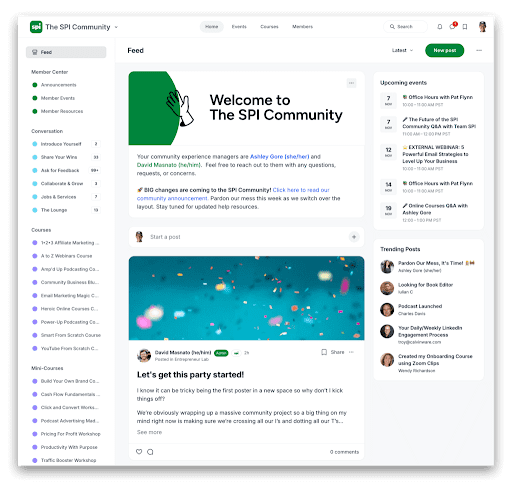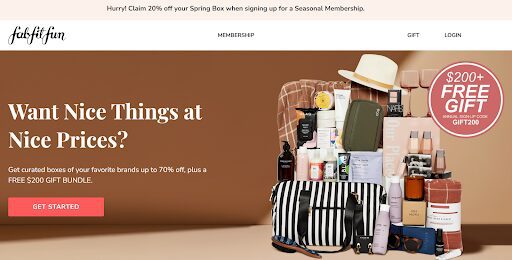9 Profitable Subscription Business Ideas That Actually Work


A subscription business is built on lasting customer relationships, providing steady income and reducing the pressure of constant customer acquisition.
This guide explores profitable subscription ideas and shows how to build them for long-term success.
Top 3 Subscription-Based Business Ideas
Here are the top three subscription-based business ideas to get you started:
1. Training & coaching
Suppose you're an expert in a niche skill or field and love sharing your knowledge. You can easily turn your knowledge into a business by offering online coaching, hosting community workshops, or creating exclusive paid content—helping others grow while monetizing your expertise.
This subscription business is perfect for you if:
- You can simplify complex ideas into clear, actionable steps.
- You have expertise in a specific skill or topic with proven results.
- You enjoy helping others grow and improve.
- You know how to structure learning to keep people engaged.
- You have strong people skills and a confident presence.
How it works:
If you have expertise in a skill or field that solves a problem or adds value, you can build a subscription business around it. This works in almost any niche, including:
- Fitness & health: Personal training, nutrition coaching, or wellness programs
- Business: Entrepreneurship, marketing, or productivity coaching
- Personal development: Mindset coaching, goal-setting strategies, or confidence-building
- Relationship advice: Dating guidance, marriage coaching, or social skills training
- Niche hobbies & skills: Crafting, coffee brewing, photography, or any specialized interest
If people can see the results that are possible with your guidance and are willing to pay for it, you’ve built a valuable offer. The key is providing consistent support, actionable learning, and personalized feedback to help customers reach their goals.
Training & coaching could be packaged to include:
- One-on-one or group coaching for personalized guidance
- Exclusive community access to discussion boards and networking opportunities
- On-demand courses, workshops, or premium content for continual learning
- Special perks like discounts, early access, or VIP experiences
Support materials such as templates, checklists, planners, and tools to enhance their journey
Here’s one successful example:
Smart Passive Income Pro is a membership platform that helps new entrepreneurs connect, access training courses, and get feedback and support for their businesses.

Why it works:
When you provide direct mentorship and real-time support, customers are more likely to stay engaged and continue their subscriptions. This creates a loyal community while giving you a stable, predictable income.
People are willing to invest in self-improvement for the long run, especially when they can see tangible progress and results. As you build your credibility, you can expand into new subscription tiers or additional income streams.
As your business grows, you can shift into a facilitator role by bringing in other experts to diversify your offerings, keeping your audience engaged and your content fresh.
Here’s how to get started:
Choose your niche
Pick a specific niche that you have deep knowledge or experience in. You don’t have to be a world-class expert; you just need to know more than your target audience and be able to simplify complex ideas into digestible content.
Validate market demand
Before diving in, ensure there’s a paying audience for your niche. Start by engaging with potential customers to understand their needs and what they’re willing to pay for. Research online trends to gauge demand, and study competitors to see what’s already working. Read their reviews, join their trials, and identify gaps in their offerings—this will help you refine your approach and create a more compelling subscription
Get started with a basic setup
When launching your subscription, keep costs low and focus on testing your offer with your audience. You can refine your setup and customer experience as you grow and see consistent profits.
Take advantage of free or affordable platforms to streamline your operations—Zoom for coaching and workshops, Teachable or Thinkific for courses, Loom for recorded feedback, PayPal or Stripe for payments, and Wix or WordPress for a simple website.
Start with a straightforward landing page that clearly communicates your offer and makes sign-ups seamless. Decide on your subscription structure early on, pricing competitively based on the value and results you provide while keeping it simple for easy conversions.
Market your offer
The success of your launch depends heavily on how well you market your offering. To build awareness and drive conversions, leverage multiple platforms:
Social media: Boost brand awareness by consistently posting relevant content that resonates with your audience.
Email marketing: Collect leads and nurture relationships through email marketing, building trust with potential customers who are more likely to convert.
Free lead magnets: Offer free trials or host webinars as teasers for your paid content, giving potential customers a taste of what they can expect from your subscription.
Advertising with partners: Rather than investing in ads on platforms like Google or Meta, partner with niche businesses that already have access to your ideal audience in order to advertise directly.
Community engagement: Build a strong presence in online communities where your target customers spend time, such as Reddit or Quora. Answer questions and provide helpful advice to build trust and gain traction.
For a more in-depth plan on marketing your online coaching services, check out these detailed guides:
- How to Earn Your First $100,000 from Coaching in 6 Steps (including email scripts)
- How to Make Money Coaching Online
2. No-Code Micro SaaS (Software as a Service)
If you have a problem-solving mindset and want to create a software product that addresses a specific need, developing a no-code micro SaaS could be a great opportunity. Offering a micro SaaS tool as a subscription-based service allows you to generate recurring revenue while keeping overhead costs low and making it possible to scale efficiently.
This subscription business is perfect for you if:
- You have some tech knowledge, or you can partner with someone who has the expertise to develop a valuable product.
- You have a great idea that uses software to solve a specific problem.
- You have identified a gap in the market for a tool that can truly add value to people's lives.
How it works:
- SaaS (software as a service) is software that users pay to access online, rather than owning it outright. As a cloud-hosted solution, it can be accessed from anywhere via the internet or an app. With the rise of AI and no-code tools, you can now easily create a simple, subscription-based SaaS that addresses a niche problem and delivers ongoing value to customers.Here are some areas to consider, depending on your niche:
- Finance: Specific calculators, accounting, or billing tools
- Media: Curated content and media derived from different websites and platforms, SEO tools
Productivity: Tools for note-taking, planning, and tracking
Here’s one successful example:
TranscriptLOL is an AI-powered software that automatically generates transcripts from media, then summarizes the content and repurposes it into social media posts or other content formats.

Why it works:
The SaaS market is booming and growing, driven by the rise of remote work and the demand for affordable, cloud-based tools.
The beauty of micro SaaS is that you don’t need to build the next Netflix or Microsoft Office—just a small, highly specific tool that people will pay a low monthly fee for.
With AI-powered no-code platforms, this field has become incredibly accessible. You can easily create and test ideas in minutes, without any heavy investment.
Here’s how to get started:
First, identify a problem that needs solving
If you’re facing a recurring problem in your industry, chances are others are too. Whether it’s streamlining content management, automating marketing, or simplifying accounting paperwork, there’s potential for a solution.
Before building anything, validate your idea by talking to potential customers or engaging in relevant forums. If demand is strong, create a landing page to explain your concept and open pre-orders to gauge interest. Offering early-bird pricing or beta access can also help attract and secure your first users.
Build your idea
Once you’ve defined your product idea, use no-code platforms like Softr, Bubble, or Glide to build it. Choose a platform that aligns with your niche and audience—whether it’s a mobile app, web app, or browser extension.
Consider your technical comfort level: do you prefer an easy-to-use beginner tool or a more advanced platform with backend flexibility?
Start with a minimal, functional version that directly solves the core problem, then refine and expand features as you grow.
Launch fast
Speed matters in SaaS, so the faster you can launch your product, the better.
List it on platforms like ProductHunt for visibility, and use promos or contests to generate buzz. Encourage users to share by offering incentives, like referral discounts or exclusive features. Most importantly, gather feedback, refine constantly, and keep improving.
As your audience grows, consider expanding your software with additional features and solutions. A tiered subscription model allows users to unlock more advanced tools at higher price points, catering to different needs and budgets while maximizing your revenue potential.
3. Subscription Boxes
If you’re interested in building a subscription-based business out of physical products, subscription boxes create a fun experience that keeps your customers coming back for more.
This subscription business is perfect for you if:
- You enjoy creating meaningful and fun experiences for others.
- You have a knack for curating gifts and packaging them creatively.
- You’re organized and skilled in managing inventory and logistics.
- You love diving deep and researching a particular interest.
How it works:
Subscription boxes are physical products containing curated items, shipped to customers on a regular basis (monthly, quarterly, etc.). These can be tailored to almost any niche, including:
- Food and meal kits
- Beauty items
- Novelty items
- Hobby and craft kits
- Clothing
- Pet products
- Dating ideas
- Books
Most subscription boxes offer a surprise selection of items within a specific theme, creating a sense of excitement with exclusive, limited-time offerings.
Here’s one successful example:
FabFitFun curates trending fashion, beauty, and lifestyle items into subscription boxes, offering members access to these products at a more affordable price than purchasing individually. They also provide customization options, allowing customers to choose items that best fit their preferences, which encourages continued subscriptions.

Why it works:
Building a curated product or service lets you immerse yourself in your favorite brands and niche interests while crafting a unique experience for your customers.
If you enjoy shopping or curating gifts but lack the time or resources to create your own products, collaborating with creators whose values align with yours can save you time and establish you as an authority figure in your niche. Partnering with established brands can also boost credibility and open up new income streams.
Here’s how to get started:
Plan and curate your ideal box
A successful subscription box starts with a clear target audience. Think about who your ideal customers are and what would make them excited to receive your package. While the products themselves matter, the unboxing experience is just as important—it should feel like a special moment.
Research other successful mystery boxes across different niches to see what makes them work. Once you’ve refined your concept, break down your costs to ensure profitability. Factor in product sourcing, packaging, shipping, platform fees, payment processing, and marketing costs. Aim for a 40–50% profit margin to cover operational expenses while keeping your business sustainable.
Source your products
When you’ve decided on the items to include in your boxes, you can start connecting and building rapport with a variety of suppliers—local artisans and makers, wholesale suppliers and distributors, brand partners, and import or export companies that can provide you with unique items in your market.
Take the time to negotiate with these suppliers on the samples needed for you to test out the boxes. Discuss minimum order quantities, discounts for different order volumes, and return policies for defective items. It’s also smart to work out a guaranteed stock availability for future boxes so you don’t end up disappointing your customers.
As a subscription box business relies on physical products, you will need to learn proper inventory management. Initially, you can handle the curation and preparation of your boxes from home, but as your business scales, consider third-party fulfillment companies that can help with this process.
Launch your box
The success of your subscription box also depends on how well you build anticipation. Share behind-the-scenes content to showcase the curation process, or collaborate with micro-influencers by sending free boxes in exchange for engaging content that reaches their audience.
Start small by offering a limited batch to friends, family, or niche communities at a special introductory price. You can also run giveaways to encourage trials—turning free recipients into loyal, paying customers.
6 More Subscription-Based Business Ideas
In addition to the three main subscription-based business models, here are six more ways you can leverage the subscription model for your next business venture:
In-Person Subscriptions
Local, in-person subscription businesses offer a unique opportunity to tap into your community while facing less competition. Plus, these businesses are often easier to market. Here are some examples to consider:
Local fitness adventure community
Build a fitness community in your area with an adventurous twist—organize weekly hikes, rock climbing sessions, pickleball tournaments, or whitewater rafting trips. The real value isn’t just the exercise; it’s the community you foster by bringing together like-minded people who love staying active and exploring new experiences together.
This model is cost-efficient and highly scalable, as you can start solo and grow by tailoring groups to different fitness levels and locations. Plus, marketing happens organically as members share their adventures on social media. Best of all, the strong friendships that form within the group often lead to high retention and continued participation.
Monthly wine & paint nights
Host regular painting sessions where guests can sip wine, learn new painting techniques, and take home their own artwork. This experience has grown in popularity as people seek offline activities where they can create and be social simultaneously.
You can rotate themes or even switch up the crafts to keep the experience fresh and exciting. High-profit margins make this model appealing, especially if you partner with local wine and art supply shops for discounted materials.
As you gain more traction, you can expand your business by offering premium tiers, such as special guest instructors or an elevated dining experience, providing even more value to your subscribers.
Service-Based Subscriptions
If you’re a freelancer or have a specialized skill, you can turn your services into retainer packages for a more predictable income stream.
This model is ideal for higher-priced services that offer clients ongoing access to your expertise and time, allowing you to plan and execute long-term projects. By creating a service subscription, you can build stronger client relationships, ensure consistent work, and stabilize your cash flow. Here are some examples to consider:
Social media management
Instead of hiring a full-time social media manager, clients can work with you on a retainer basis for all aspects of their social media presence. This can include everything from strategy development to execution and reporting, all for a monthly fee.
This business model benefits both you and your client—you offer long-term strategies and solutions that you help to implement, while they provide you with a steady retainer fee, ensuring predictable income.
The added benefit of working closely with your client on ongoing projects is that you can drive more impactful results, increasing your chances of gaining referrals from their network.
Virtual styling/beauty advising
If you have a passion for fashion or styling, offering a retainer service as a virtual stylist or beauty advisor is a great business idea.
Ideal clients could include celebrities, influencers, and public figures who need assistance with outfits, accessories, and makeup for media appearances or photoshoots. You’d provide services like creating mood boards, lookbooks, and styling recommendations. Some stylists also offer personal shopping services.
This model is ideal because it requires no physical inventory and allows you to work with clients worldwide. Once established, it can lead to long-term relationships and referrals, helping your business grow organically.
Digital Content-Based Subscriptions
These models focus on providing ongoing, valuable content to a loyal audience. Here are some examples to consider:
Industry deep-dive newsletter
Create a subscription-based industry newsletter that provides actionable insights and keeps professionals in your niche up to date. Whether it's tech, crypto, or real estate, your newsletter can include market trends, job postings, curated deals, exclusive interviews, case studies, and breaking news—all in one place.
This model is highly scalable with minimal overhead. Once you’ve built a loyal audience, you can repurpose content into other products, offer upsells like courses or consulting, and develop a consistent revenue stream.
Digital resource library
Similarly, you can create a subscription-based digital hub offering valuable resources for a niche audience—think e-books, templates, tutorials, and more. The goal is to help your subscribers save time and work smarter. With fresh content released monthly, this model keeps your audience engaged while delivering ongoing value.
This approach allows you to frontload your effort and sell the resources repeatedly. It offers a clear value proposition by providing instant access to essential tools. Additionally, you can introduce premium tiers that include offerings like coaching calls or custom content to boost your revenue.
Tips to Ensure Your Business Idea Succeeds
To build a profitable subscription-based business, thorough research and careful planning are essential from the start.
If you're ready to launch, here are some tips to ensure your business idea is on the right track:
Use the Pay Certainty Technique
Before committing significant time or resources to your business, it's crucial to test whether your target market is willing to pay for your offering.
Here’s how you can ensure your pricing strategy is spot on:
- Research competitors: Analyze your competitors’ pricing so that you can better understand the market and set a realistic benchmark for your own pricing.
- Understand your audience's spending power: Consider the financial capabilities of your target audience, and then make sure your prices are aligned with what they are willing and able to spend.
Validate pricing: Conduct surveys, engage in conversations with potential customers, or use online discussion boards and forums to directly ask your audience how much they’d pay for your product or service.
Use the Demand Matrix to target the right market
The Demand Matrix helps you position your product or service by categorizing potential markets based on price and customer volume. Understanding where your business fits can guide your strategy to target the right market.

Here’s how the Demand Matrix works:
- Top right: Golden Goose (High Price, Many Customers)
This is the ideal quadrant to target. A product or service that appeals to a large audience and also warrants a premium price can help you scale your business without overwhelming you. Aim to position your offering as a high-value, sought-after solution for a broad audience. - Top left: Mass Market (Low Price, Many Customers)
While this model might seem appealing for its wide audience, it’s often not recommended for beginners due to the challenges of managing high-volume sales at low margins. If you choose this route, ensure you have scalable systems in place to manage large orders without burning out. - Bottom right: High-End (High Price, Few Customers)
This quadrant allows you to target fewer but high-paying customers, which can be a more manageable approach. If you're looking for a sustainable business model without the pressure of mass-market volume, this is a great option. Offering premium services to a smaller audience allows you to maintain quality and build long-term relationships. - Bottom left: Labor of Love (Low Price, Few Customers)
This is a quadrant you want to avoid for sustainability. While the business may be born from passion, it often lacks scalability and profitability. If you still want to pursue this, it’s essential to understand that it will likely be a hobby business or something that requires careful cost control and niche appeal.
Subscription-based businesses offer a powerful path to stable, predictable income without the constant hustle for new customers. By fostering strong relationships and consistently exceeding expectations, you’ll set the stage for sustained growth and long-term success.
If you like this post, you'd love my Ultimate Guide to Profitable Business Ideas